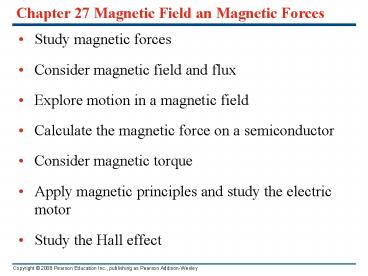Chapter 27 Magnetic Field an Magnetic Forces - PowerPoint PPT Presentation
1 / 23
Title:
Chapter 27 Magnetic Field an Magnetic Forces
Description:
Chapter 27 Magnetic Field an Magnetic Forces. Study magnetic forces ... In 1820, Hans Oersted ran a series of experiments with conducting wires run near ... – PowerPoint PPT presentation
Number of Views:1058
Avg rating:3.0/5.0
Title: Chapter 27 Magnetic Field an Magnetic Forces
1
Chapter 27 Magnetic Field an Magnetic Forces
- Study magnetic forces
- Consider magnetic field and flux
- Explore motion in a magnetic field
- Calculate the magnetic force on a semiconductor
- Consider magnetic torque
- Apply magnetic principles and study the electric
motor - Study the Hall effect
2
Magnetism
- Magnetic north and south poles behavior is not
unlike electric charges. For magnets, like poles
repel and opposite poles attract.
- A permanent magnet will attract a metal like iron
with either the north or south pole.
3
The magnetic poles about our planet
Magnetic poles reverse every 5000 to 50,000
yrs. Proof is from plate movement
4
Magnetic poles vs. Electric poles?
- We observed monopoles in electricity. A ()or
(-) alone was stable and field lines could be
drawn around it. - Magnets cannot exist as monopoles. If you break
a bar magnet between N and S poles, you get two
smaller magnets, each with its own N and S pole.
5
Electric current and magnets
- In 1820, Hans Oersted ran a series of experiments
with conducting wires run near a sensitive
compass. The result was dramatic. The orientation
of the wire and the direction of the flow both
moved the compass needle. - There had to be something magnetic about current
flow.
6
The interaction of magnetic force and charge
- The moving charge interacts with the fixed
magnet. The force between them is at a maximum
when the velocity of the charge is perpendicular
to the magnetic field. Force F q v B - B Magnetic Field F/qv 1N-s/C (1A 1C/s )
The units of B are Teslas T 1N/A m 1T
10,000 gauss (G) - The earths magnetic field B 1G
- B is a vector and is defined as the direction the
north pole of a compass needle will point.
7
The right-hand rule I
- This is for a positive charge moving in a
magnetic field. - Place your hand out as if you were getting ready
for a handshake. Your fingers represent the
velocity vector of a moving charge. - Move the fingers of your hand toward the magnetic
field vector. - Your thumb points in the direction of the force
between the two vectors.
8
Right-hand rule II
- Two charges of equal magnitude but opposite signs
moving in the same direction in the same field
will experience force in opposing directions.
9
Direction of a magnetic field with your CRT
- A TV or a computer screen is a cathode ray tube,
an electron gun with computer aiming control.
Place it in a magnetic field going up and down. - You point the screen toward the ceiling and
nothing happens to the picture. The magnetic
field is parallel to the electron beam. - You set the screen in a normal viewing position
and the image distorts. The magnetic force is
opposite to the thumb in the RHR.
Force for a Negative charge
10
Magnetic field lines may be traced
- Magnetic field lines may be traced from N toward
S in analogous fashion to the electric field
lines.
11
Magnetic Field Lines for common sources
12
Magnetic flux through an area
- We define the magnetic flux through a surface
just as we defined electric flux. Figure 27.15
illustrates the phenomenon. - Follow Example 27.2, illustrated by Figure
27.16.
13
Motion of charged particles in a magnetic field
- A charged particle will move in a plane
perpendicular to the magnetic field. - Figure 27.17 at right illustrates the forces and
shows an experimental example. - Figure 27.18 below shows the constant kinetic
energy and helical path.
14
Motion of Charged Particles in a Magnetic
Field (Chapter 27, Sec 4)
Because F is always perpendicular to v, v is
constant. Therefore, the charge will travel in a
circle with radius R.
15
A magnetic bottle
- If we ever get seriously close to small-lab
nuclear fusion, the magnetic bottle will likely
be the only way to contain the unimaginable
temperatures a million K. - Figure 27.19 diagrams the magnetic bottle and
Figure 27.20 shows the real-world examples
northern lights and southern lights.
16
J.J. Thompson was able to characterize the
electron
- Thompsons experiment was an exceptionally clever
combination of known electron acceleration and
magnetic steering.
17
Bainbridges mass spectrometer
- Using the same concept as Thompson, Bainbridge
was able to construct a device that would only
allow one mass in flight to reach the detector.
The fields could be ramped through an
experiment containing standards (most high vacuum
work always has a peak at 18 amu). - Follow Example 27.5.
- Follow Example 27.6.
18
The magnetic force on a current-carrying conductor
- The force is always perpendicular to the
conductor and the field. - Figures 27.25, 27.26, and 27.27 illustrate.
19
Magnetic force on a straight then curved
conductor
- Refer to Example 27.7, illustrated by Figure
27.29. - Refer to Example 27.8, illustrated by Figure
27.30.
20
Force and torque on a current loop
- This basis of electric motors is well diagrammed
in Figure 27.31below.
21
Force and Torque on a Current Loop (Chapter 27,
Sec 7)
(27-21)
A ab area of coil
Figure 27-29
For an N turn coil
(27-28)
22
The Direct-Current Motor
Figure 27-37
23
The Hall Effect
- Considers the forces on charge carriers as they
move through a conductor in a magnetic field. - Follow Example 27.12.

